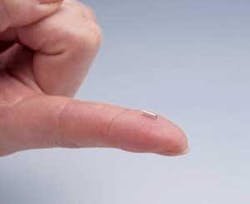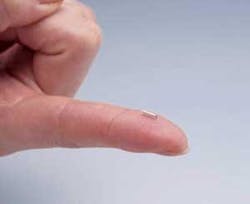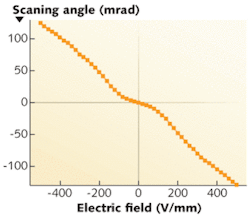LASER SCANNING: Nonlinear crystal becomes high-deflection beam scanner

Potassium tantalate niobate (KTN), a nonlinear optical crystal first synthesized in the 1950s, is well known as a crystal with a very large quadratic electro-optic effect (Kerr effect). Researchers at NTT Advanced Technology (NTT-AT; Tokyo, Japan) have been creating ultra-high-quality KTN crystals, achieving a dielectric constant higher than 20,000 and a Kerr electro-optic coefficient of 2.2 × 1014 m2/V2, which corresponds to a Pockels coefficient of 2200 pm/V with a bias field of 100 V/mm (about 70 times larger than that of lithium niobate).
Now they are using the crystal in another way: to form a high-speed, voltage-controlled laser-beam scanner that operates on the principle of electron injection. The scanner has no moving parts, scans in two dimensions in both continuous and step scanning modes, and has a very large beam deflection of up to 250 mrad (14°). It can be used with wavelengths in the 532 to 4000 nm range.
Novel phenomenon
The new approach to optical-beam scanning was discovered in 2006.1, 2 Theoretical and experimental investigations by NTT-AT scientists showed that the phenomenon is based on injected electrons that exist as true charges in the crystal, causing the applied electric field to become nonuniform between the electrodes. According to theoretical analysis, the electric field is proportional to the square root of the distance from the cathode. Because the KTN crystal has an extremely large quadratic electro-optic effect, the electric field induces a linear graduation of refractive index inside the crystal, causing a linear phase delay across the beam that deflects the beam. The 250 mrad deflection angle was produced by applying ±250 V to a 0.5-mm-thick KTN crystal with a short interaction length, says NTT-AT researcher Kazuo Fujiura. The phenomenon is called “space-charge-controlled electro-optic effect” by the researchers.The scanning speed of the KTN scanner is about 100 times faster than that for polygon- or galvanometer-mirror scanners, while its scanning angle is about 100 times larger than that for conventional prism-type electro-optic (EO) scanners. As a result, the KTN scanner brings the advantages of EO scanners (no mechanical movement; flexible operation modes that include step, continuous, and analog or digitally programmable beam scans; and extremely high deflection rates) to applications that previously required mechanical scanners, such as laser processing, imaging, printing, copying, and laser machining.
The KTN scanner has been built into a thermoelectrically cooled module (nttg-rd.com) 20 × 30 × 60 mm in size with a scanning angle of ±5° and a response frequency of 100 kHz; NTT-AT is exhibiting the device at the Conference on Lasers and Electro Optics and the 27th International Quantum Electronics Conference (CLEO/IQEC 2009; May 31 to June 5, 2009; Baltimore, MD), where it will make the KTN scanner available for the R&D sector.
REFERENCES
- 1. K. Nakamura et al., Appl. Phys. Lett. 89, 131115 (2006).
2. K. Nakamura et al., J. Appl. Phys. 104, 013105 (2008).
About the Author
John Wallace
Senior Technical Editor (1998-2022)
John Wallace was with Laser Focus World for nearly 25 years, retiring in late June 2022. He obtained a bachelor's degree in mechanical engineering and physics at Rutgers University and a master's in optical engineering at the University of Rochester. Before becoming an editor, John worked as an engineer at RCA, Exxon, Eastman Kodak, and GCA Corporation.


